Meaher State Park, Spanish Fort, Alabama
We went sightseeing all day today, but we only visited two places with a stop in between for a great meal at Felix’s Fish Camp Restaurant. Even so, I have a lot of information and pictures.
It was foggy and cloudy and windy again, with a promise of temperatures near 80 and clear skies.


The drive in to Mobile

You have to go through a tunnel, no matter which way you go in or out of town.
Unless you choose to go over an hour out of your way . . .
And I was excited to begin the day. We visited the Mobile Carnival Museum and it was even more than I was expecting!

The door on the side is the entrance



We had absolutely no idea what all was involved in Carnival! For one thing, who knew America had royalty! So before we get to the multitude of pictures we took, let’s learn some history. I’ve chosen to pass on to you a much condensed version of my 3 hours of research, not to mention what we learned in the museum. If I tried to convey even half of it, I’m afraid you’d be reading for days. You can thank me later.
- Mobile is the birthplace of Mardi Gras. Yep. Not New Orleans, Mobile. Of course this is a much disputed fact between the two cities. From what I’ve read, it sounds like it started in Mobile in 1703, ran for a bit then stopped for a bit, then restarted years later. New Orleans started late, but kept going, borrowing things/ideas/traditions from Mobile.
- For years, Mobile had two parades – one given by the Cowbellion de Rakin Society which was on New Year’s Eve and the other was the now known Mardi Gras.
- The “Cowbellions” began when a drunk cotton broker slumped on the porch of a hardware store in town and got tangled up in rakes and cowbells. He tied them together, and paraded down the street making a racket. The local paper wrote about it and speculated if he’d do it the next year. He gathered up some friends and they did. Being a closed society, they never added more members and eventually the Cowbellion de Rakin Society died off.
- Mardi Gras in Mobile was revived when after the Civil War, a man named Joe Cain came back from visiting New Orleans and held a parade on Fat Tuesday dressed as an Indian, which he named “Chief Slackabamarinico”. Mobile was still occupied by Union forces. Joe Cain Day is the first celebration of the season. Somehow, it’s also sparked another society parade on the same day – The Joe Cain Widows/Mistresses parade. The wives dress in modest black and carry black roses, the mistresses wear bright red tea dresses and throw red roses. Apparently, they spend the day drinking and arguing about which one he loved the most. (???)
- Today, “maskers” (people on the floats – and yes, they all wear masks) throw, among other things, moon pies – HALF A MILLION of them! They do this because one of the ladies’ secret societies discovered them (soft, heavy enough to throw, cheap) in the 1960’s. It’s grown since then. Plus in 1972, Cracker Jacks were outlawed as “throws” (as they call the stuff that’s thrown) because of the risk of the boxes hurting someone. (Bet Cracker Jack didn’t like that much!)
- Since it’s resurgence in 1867, Mobile’s Mardi Gras has only cancelled a total of 5 times – during WWI and WWII.
- Mardi Gras made its way to New Orleans because they moved the capital of the French Louisiana Territory in 1718 due to a fear of hurricanes.
- There are two kings – King Felix III, of the secret/very exclusive Mobile Carnival Association (MCA), and King Elexis I, of the secret/very exclusive Mobile Area Mardi Gras Association (MAMGA) and since every king needs a queen, they’re simply called “Queen of Carnival” and “Queen of MAMGA”.
- A tour guide we met up with at the museum for a few minutes told us the trains alone cost in the six figures and crowns start at $600 and can reach into the thousands. And then there’s the suit/dress and scepter. Gulp!!
- Speaking of cost, each society that parades pays for their own parade. I found a partial list of expenses:
Costumes, luncheons, tickets to balls, annual dues for the members, making/renting the float, entertainment on the float, the ball, insurance, parade throws…they can all add up to more than $50,000 a year. But no one really knows for sure in the secret societies because no one knows who the members actually are, so no one knows the expenses. Dues are estimated to run $1-2,000 per year.
Floats: $53,000
Float Barn: $39,400 (storage for the float)
Costumes: $32,000
Insurance for the Parade: $4,800
Horses: $3,200
Truck rental for pulling the floats: $715
Drivers for the Float: $1,105
Float security,emergency road service, banner carriers, and generator rental:$2,670
Beads and trinkets: $500 per float rider
These figures are from 2013, so obviously it’s even more expensive!
- Besides the attire, the kings/queens royal responsibilities begin nearly a year before their coronations on the Wednesday before Thanksgiving. Their time is spent designing their trains, crowns and scepters, hosting parties and making appearances, which could include as many as 40 fancy celebrations. King Felix III is required to host 2 parades, one on Lundi Gras (held on Shrove Monday which is the Monday before Fat Tuesday) and the other on Mardi Gras Day, as a gift to the city. The Kings are also required to host several royal feasts and luncheons.
- The royal courts are made up of prominent Mobile families who’ve been a part of Mardi Gras for many generations. About a year in advance, the MCA officers select the kings and queens, but details of the process still remain secret.
- Mystic Societies. They’re private, non-profit groups that celebrate Carnival either with a parade or a ball or both. They meet all year to plan each year’s theme and events. The largest parading groups build and store their own floats. Some of the smaller groups rent floats from the larger groups. Most of the groups keep their members’ identities secret, which is a tradition from the earliest Medieval Carnival celebrations.
There is soooooo much more, but that’s more than enough I think. Enjoy the pictures!! Then we’ll eat and talk about our second adventure – the USS Alabama Battleship Memorial Park.
They send you into this large room first. You begin the tour here, either by using their app on your phone (that’s what the numbers are you’ll see periodically), or with a tour guide.
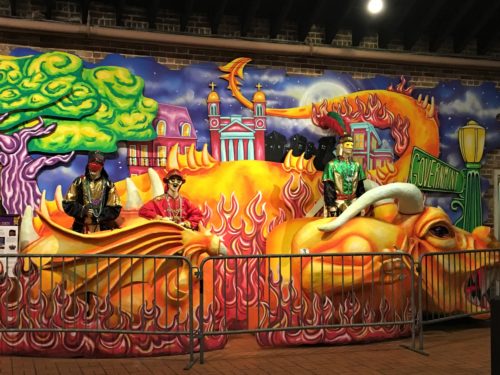
This is a scale copy of one of the floats they use every year.
The following two signs will explain.



The eye of the dragon.
It’s one of those electronic spheres where the beams move around.

This is Jester and Death.
Since the beginning of the Order Of Mystics parade (OOM), they’ve chased each other around the pillar on their float.

Dress up!! Yeah!
Mostly for smaller kids though, but we made it work. : )


Who is that pink masker?

Oh! It’s you! : )

Queen of Carnival

King Felix III
And now, we’ll enter the actual museum part:
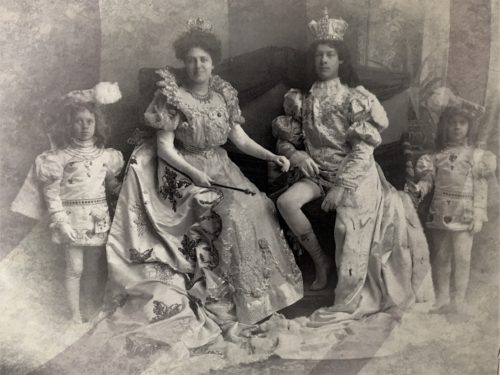
King, Queen and court
1889

The Queen
1922
Take a look at the name! : )
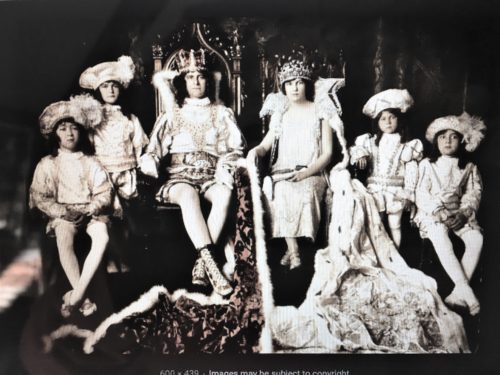
King, Queen and attendants
1924

MCA King Felix III
2018
Parker Shearer

MAMGA King Alexis I
2018
John Finley IV

MCA Queen of Carnival
2018
Lucy Mostellar

MAMGA Queen
2018
Tiffany Hall

This is one of many examples of the elaborate trains I took pictures of!

The previous train went with this dress

They had a couple of display cases with some of the gifts the kings and queens have given their courts. This was one of the more unusual ones.


Just look at the details on this MAMGA King’s train!


These are his crown and scepter
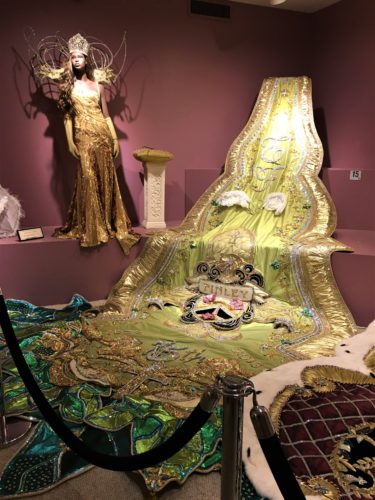
And the MAMGA Queen’s!




They converted an old house into the museum


Get a load of these shoes!
By the way – – they’re all like that! Or even more elaborate!

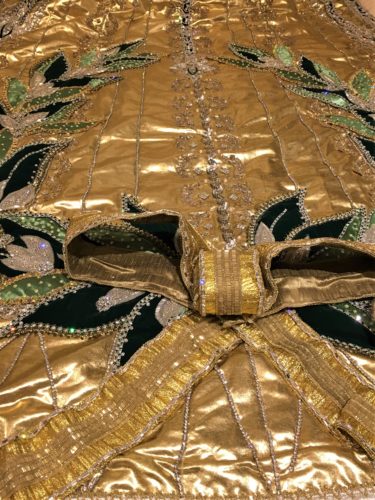
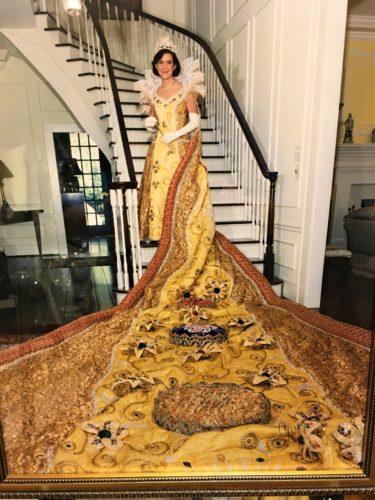



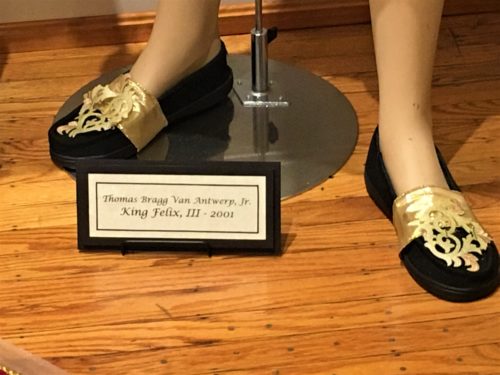



The crowns on her train represent each of the people in her family who’ve been on the court!


We didn’t know what a striker was. Here’s what I found:
The Strikers (officially The Strikers Independent Society) is a mystic society founded in 1842 in Mobile, Alabama and participated in Carnival during New Year’s Eve and New Year’s Day celebrations. It is the oldest remaining mystic society in America but no longer hosts an annual parade, though in 1996 just for fun they held their first parade in 115 years.
Their name is taken from the act of striking or marking cotton bales.

Can you imagine?
This wooden goat, that’s just sitting out in the open, is considered priceless???

These next couple are from Junior Kings and Queens.
They’re not quite as long. : )




Paige outfit

This is the oldest crown in the museum’s collection.
The next picture will tell you about it’s history.


I think this was a generational picture?

Now we’re into the sillier side of things.
These Comic Cowboys have their own parade –
and as you’ll see, their own “queen” (in a fun sense, not literally)




“Little Eva”
Queen of the Comic Cowboys

I’m not sure what these costumes represent.
This is when we caught up with the tour guide and felt we had to stick with him because the other couple left in the middle of his talk!


Joe Cain aka Chief Slackabamarinico and his mistress and widow
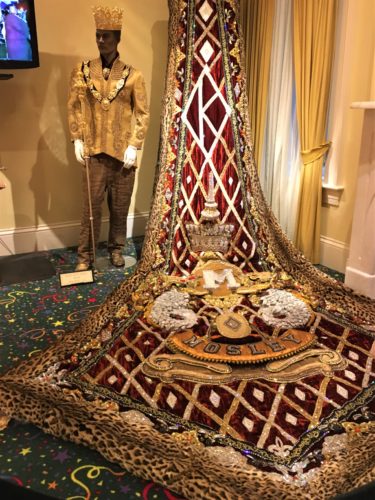


Some of the umbrellas people on the floats carry



This family donated just about everything.
See the display of dishes?

The name of the hardware store is the one where the drunk guy started the Cowbellians


This dress and train is from 1936.
I don’t know how, but according to the guide, they do clean these things once in a while.
Seems to me they should be more protected!

This Striker’s table is also quite valuable!





They had a small room with music memorabilia, but the King and Queen attire is definitely the main attraction!
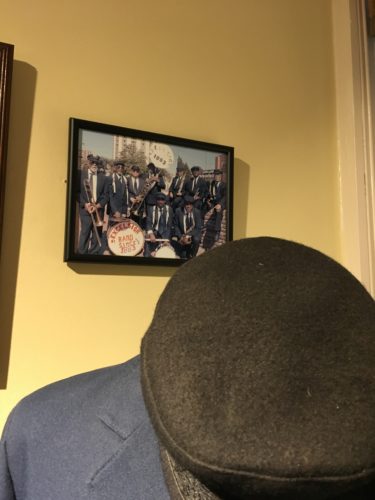
This was a small tribute to this jazz group who have played in many, many parades – and still do.






Here’s a table setting that was donated to the museum.
It was custom made for the Coronation Ball.
I’m not sure if it was for everyone in attendance, or just for the Court.
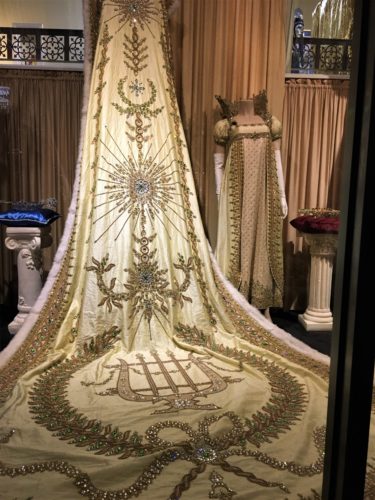
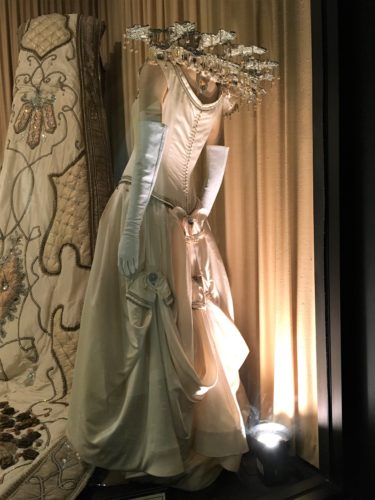
According to the guide, this dress is an original Vera Wang. Original, as in, she met with the Queen and designed the dress herself!
Thus ends your tour of the Mobile Carnival Museum.
Time for lunch!
Felix’s wasn’t nearly as exciting as Lambert’s since there was no food thrown, but what we had was terrific and so was the view! They sat us at a table with a view of the bay. It was still really foggy over the water when we sat down, but by the time we were done, it was much clearer!


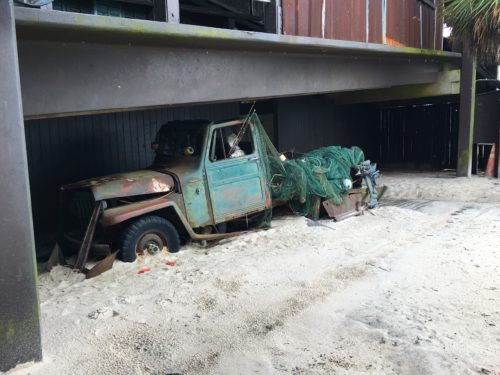

This was our view when we were first seated

Look how much it cleared out!

This was an oyster appetizer. Very, very good!
They’re sitting on a bed of salt, in case you were wondering.
Blaine had crab cakes on a bed of fried green tomatoes, I had the white fish stuffed with a crab cake. We shared. : )
Now that our bellies are full, we decided to go to the Battleship Park. And no, we hadn’t decided what to do after we ate. That’s the fun of retirement! We don’t always have to plan our days!
The USS Alabama is very similar to the North Carolina, which we’ve visited several times. This was part of the reason we hesitated paying to go. However, there’s more here than just the battleship and, we’re eligible for a senior discount here! For some reason, they figure “senior” at age 55. We’re well past that.
This Park has been self-sufficient since it opened on January 9, 1965 and depends solely on admissions and Park revenue for its daily operations. They have some signs here that you won’t see too many other places, like ‘flip-flops, sandals and high heels are worn at your own risk’. 😊
So. The Alabama. One of the main differences between this and the NC, is the restoration and the access we had to each area. We saw much more of the Alabama! In fact, there was so much that it took us longer than anticipated and we almost ran out of time to see the other things here! There are actually three different tour paths inside and around the ship, and they give you a guide to follow the numbers. It’s doesn’t have descriptions of what you’re looking at, just the name of it. For example: Descend the Red Tour ladder to Second Deck. Turn left toward stern of ship. On your right is the Engineers Office (1).
Needless to say, with an entire ship to search through, there was a lot of walking and climbing! We were both wearing tennis shoes, so we were Ok. 😊
The Alabama was commissioned August 16, 1942 and during WWII, shot down 22 enemy planes. She’s 608 feet long (about 2 football fields end to end) and 108 feet (36 yards) wide. She carried 127 officers and normally had a crew of about 2,500 men on board. And for you guys out there, there are nine 16” guns accurate to 21 miles, Twenty 5” guns, forty-eight 40mm guns and fifty-two 20mm guns. That’s a lot of guns! And a lot of ammunition needed!

The USS Alabama



After being on this ship with a few other tourists (hard to guess how many), I can’t even begin to imagine having close to 3,000 people on here all at once! I looked it up just for frame of reference, the Akron Civic Theater holds just under 2,600, so virtually the same.
Permission to come aboard?
Permission granted.
Here’s our pictorial tour of the USS Alabama:

The machine shop

Hmmm . . .
That meat doesn’t look so good . . .

. . . but the fruit sure does!





This is the brig.
Be sure to look over the regulations, some are pretty interesting.



I’ve never seen the latrine inside a battleship before.
This is just gross!
I wonder if the newer ones are better?

And here’s where they bathed, brushed teeth, etc.

Dentist


Laundry

Darkroom

This is where the photographers slept and kept their gear.
Look at those cameras!
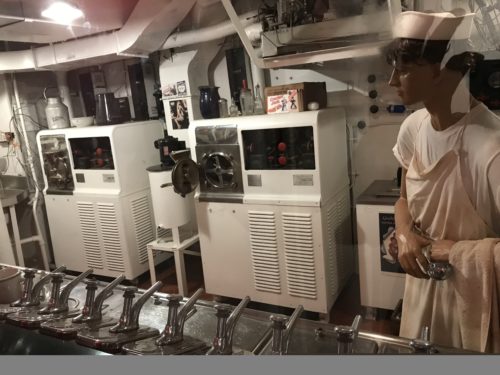
Every ship should have an ice cream parlor!!



Bob Feller
Do you remember/know of him?
He was “Baseball’s Greatest Living right-handed pitcher”, but he gave it all up to serve his country. How many would willingly do that today?


According to the signs, this was his bunk.



CPO Pantry



Some of these products are still around!


They have a Memorial Room for all who served.
You can look up people on the screen.
Blaine found a Peck.
He doesn’t think it’s any relation, though.



Temporary Brig

Officer’s Quarters


Chief Master at Arms Quarters
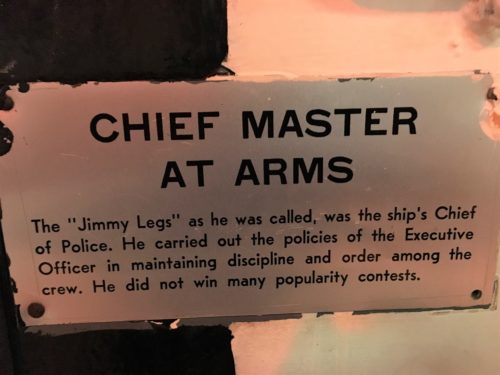



Safes in the Disbursing Office

Just look at these tight quarters!


Warrant Officer’s Mess

Here’s one of their rooms.
This one belonged to the Ship’s Carpenter

Lighting Transformers
Still in use

Additional lighting transformers
Also still in use
Good thing!

There’s a name for this room, but neither of us can remember it.
It’s where they plotted their guns.


The engine room was so huge, there’s no way to take a picture, so this is what I got. : )
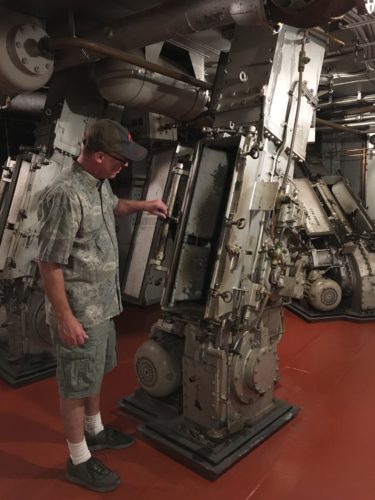
The gun/”bullet” loading place.
I’m so technical, aren’t I?? : )

One of the “bullets”

This is another part of the same room

See something you recognize?

Communications

The Chapel
Pretty small for a 3,000 crew ship . . .

They have wooden decking.
That surprised me, but Blaine says they laid it down over steel so it wouldn’t be slippery.
Makes sense to me!

Our tour took us outside for a bit.
View of Mobile


Officer’s Mess

Captain’s Quarters

Another view from outside

Eventually, we’ll come outside just at the bottom of the flags.


I love this picture!
Makes it looks like we’re at sea! : )

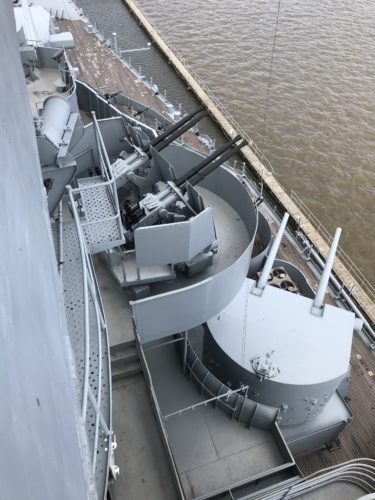

Take in the skyline and also, the building.
The building is the hanger for all the aeronautics museum

Climbing into . . .
well, I don’t know what it was, but it was really small quarters in there, and as you can see, not easy to get into.
The door comes past my knees!

Mission accomplished.
Just because.
We rushed a bit through the end because we discovered how late it was and we need to get to the submarine – the USS Drum.
The Drum was commissioned on November 1, 1941. It’s 311 feet long and 27 feet wide. She held 7 officers and 65 crew. This is the extent of the information given us.

The USS Drum


Believe it or not, this is part of the USS Drum, although it’s beyond me how they can have a gun like that on a submarine.

Once again, extremely tight quarters! Of course, that’s to be expected on a submarine. I could never have been a sailor – especially on a sub! Too enclosed for too long. I was ready for fresh air after the 30-45 minutes we were on board, and there was only a handful of people by then!

Torpedo Room


Wardroom

Wardroom (other side of the tiny room)


I don’t remember who slept here
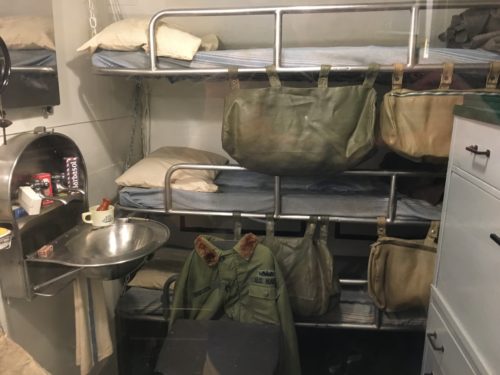
Or here . . .


I can’t remember if this was a gas mask, or “scuba” type equipment, but it’s somethin’ isn’t it??

Steering the sub

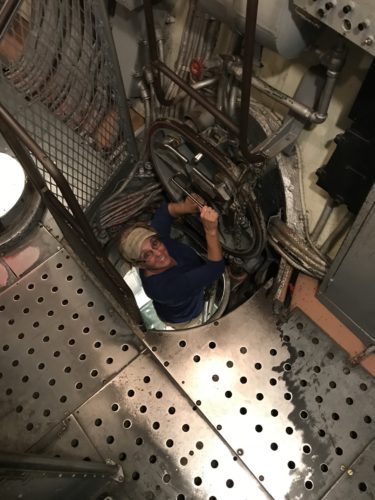
Climbing up into where the periscope is.
A little nerve-wracking, but I did it!

I think these were all for the periscope because there was nothing else up here.


Fresh baked bread! Yummm!!

More tight quarters

Engines


Blaine was fascinated with these pistons.
I’m sure the guys will understand why. : )


Flag on the sub with the Alabama in the background


This concludes our tour of the USS Drum. That is all. (They said that after all the public service announcements today.)
After the Drum, we still had time to visit the aircraft museum. They fit quite a few large planes in this relatively small hanger! We saw signs that many were on loan from a Pensacola, Florida museum and wondered a bit why that would be. And then we saw the before and after Hurricane Katrina pictures. There were only a couple, but we got the picture. How disheartening!
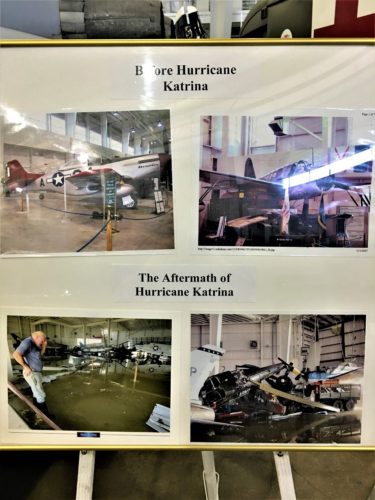










The Presidential Helicopter of Ronald Regan




The hanger where they keep all the planes.
Doesn’t look big enough, does it?
After the museum, it was about closing time, but we still had a few minutes to tour the grounds some. That’s where they keep the tanks, and other humongous aircraft.

“Calamity Jane” a B52 bomber


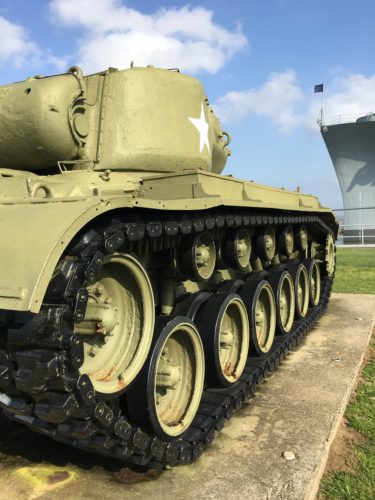

Looks broken to me . . .
But it’s not.
Home to put our feet up!
We did get back up for a few minutes to watch the sunset.


In case anyone is wondering why I’m a week behind, I kept track of my hours this time. I spent almost 13 hours from start to finish to complete this post, what with research, editing, uploading and technical difficulties. The log says I visited this particular post 16 times during that week.
TOTAL HIKING MILES: 6 (total guess, but it was a lot!)
Year To Date: 216
Daily Average: 2.76
